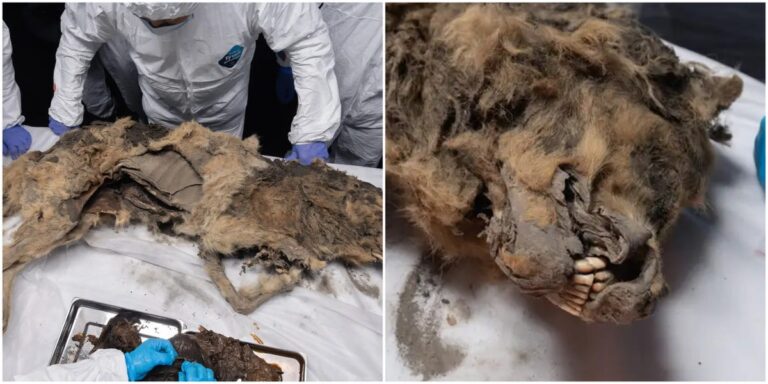In 2021, residents of Yakutia in eastern Russia found the wolf in thick permafrost – soil that normally remains frozen year-round but in many places has begun to thaw as global average temperatures rise.
Now, researchers at the North-Eastern Federal University in Yakutsk, Russia, are studying the mummified remains to learn more about the animal.
The frozen conditions allowed the Pleistocene predator to be mummified and perfectly preserved. Its teeth and much of its fur are still intact, as are some of its organs.
The wolf is immaculately intact, with teeth and fur. North Eastern Federal University
“It’s shocking, actually,” Robert Losey, an anthropologist at the University of Alberta who was not involved in the research, told Business Insider.
“This is the only complete adult Pleistocene wolf ever discovered, which in itself is truly remarkable and completely unique,” he added.
There is much to learn from such a well-preserved ancient animal, including its genetics, lifestyle, diet, and even the types of ancient bacteria and viruses it had.
“Living bacteria can survive for thousands of years, making them a kind of witness to these ancient times,” Artemy Goncharov, a researcher at the Institute of Experimental Medicine, said in a translated statement.
The wolf’s stomach can hold its last meal and much more
Scientists examine the wolf’s stomach for signs of its last meal and ancient microbes. North Eastern Federal University
The 44,000-year-old wolf is likely an extinct species and was probably larger than modern wolves, Losey said. Studying the animal’s genome will help determine its place in the canid family tree.
After examining one of its teeth, scientists believe it was an adult male. It probably hunted in a flat, cold environment populated by mammoths, woolly rhinoceroses, extinct horses, bison and reindeer.
The remains of some of these animals could even be left in the wolf’s intestine. Researchers took samples from his stomach and digestive tract to learn more and are awaiting the results.
Researchers can They may also be able to determine what functions the ancient microbes served in the wolf’s gut and whether it contained parasites, Losey said. If any of these microorganisms are unknown to science, they could play a role in developing future drugs, the researchers said in the statement.
The discovery is just one part of a larger collaboration to study other ancient animals, including fossils of hares, horses and bears. The researchers have already studied a wolf head from the Pleistocene era and have another wolf fossil awaiting dissection.
Ancient animals and infectious agents are thawing
Scientists have observed traces of other viruses in the permafrost. jitendrajadhav/Getty Images
As permafrost melts due to rising global temperatures, older creatures like this one are re-emerging. In the Yukon, for example, paleontologists are still admiring a perfectly preserved baby mammoth discovered in 2022.
However, not everything found in permafrost is so harmless.
In 2016, melting snow on Siberia’s Yamal Peninsula released anthrax from a frozen reindeer carcass, causing an outbreak that infected 36 people and killed a child.
Researchers fear other pathogens lie dormant in the tundra as the thaw of a warming planet slowly moves toward them.
Last year, researcher Jean-Michel Claverie announced that he had resurrected a 48,000-year-old virus discovered in Siberian permafrost. It could still infect single-celled amoebae.
“We view these amoeba-infecting viruses as surrogates for all other possible viruses that could be in permafrost,” Claverie told CNN at the time. “We see traces of many, many other viruses. So we know they’re there. We don’t know for sure if they’re still alive.”
Any ancient viruses or bacteria found in the Yakutian wolf’s gut could help researchers better understand the microbes lurking inside the permafrost creatures.


